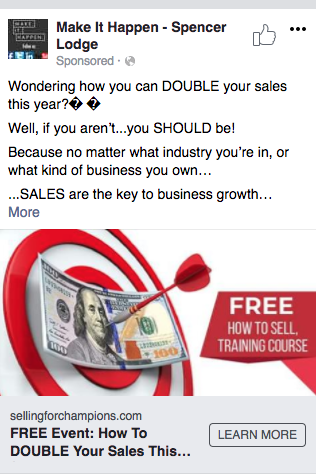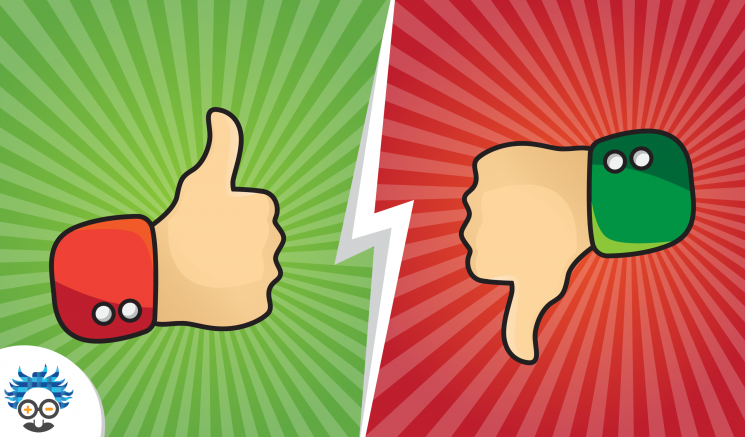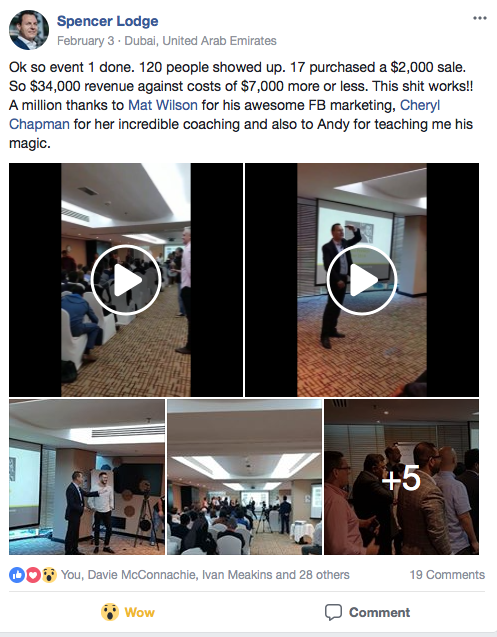Events are mysterious creatures…
…but don’t worry, this step-by-step guide will show you how to fill your first event.
And the best thing about it?
These instructions don’t require marketing lists, or an enormous budget.
However, this is not a get-rich-quick-strategy. You must have the following to make our event strategy work:
- A high-quality high-ticket product
- Working capital
- Stage confidence/experience
Got it?
Let’s get into this…
Contents
Step 1- The Event Funnel
Before we dive into the nuts and bolts of registrations, let’s talk about foundations.
An event funnel is the first thing you’ll need. This is a website that offers only two options to visitors, take the next step or exit.
This is your bedrock. It’s going to swallow the visitors you drive its way and push out registrations.
In order for it to do that, we use a simple 3-page funnel.

- Page 1- Registration Page
Registrations require longer form copy. The more information included here, the higher your show up rate will be (we’ll explain more about this a little later).
If you have done previous events, include photos. If not, add a video of you speaking about the upcoming event.
- Page 2- VIP Upsell
This stage is vital for liquidating marketing spend.
The VIP Upsell pitch is made on video with a button (that appears after you’ve made the offer) taking them to a payment page.
We recommend VIP guests are given front row seats, lunch, and a free digital product (if you have one).
- Page 3- Thank You and Reconfirmation of Event Details
The third page is crucial.
You must reconfirm the event details in text, and in a Thank You video.
This should include the time, location and your contact information.
Step 2- Location, Location, Location

Choosing a room can cause a lot of problems.
Remember, this is your first event, not a seminal world tour after re-releasing your Greatest Hits for the third time in 20 years. We don’t need chandeliers or trays of caviar.
Simple is better.
Go for a wide room, allowing you longer rows, and more people close to the stage. You’ll create a much stronger connection with your audience if they’re nearby.
Avoid rooms with pillars, or obstacles, and make sure your stage has a plain backdrop (no paintings or features) and that AV is included in your deal.
We’d advise aiming for an audience of 50 people at your first event. So, look for rooms of about that size.
If you book a room for 100-150 people, expect to pay 40% more. This will take a chunk out of your marketing budget and may result in a loss of sales…
…because filling a room at anything under 80%, will frame you poorly when it comes to making a sale at the end of an event.
Step 3- Go Live

Update your funnel with room details/dates and turn that conversion machine on, because now’s the time to send visitors over there…
…with the power of Facebook advertising.
You should go live with your Facebook Ads two weeks before your event date. This will ensure that your show up rate is high and your marketing spend is not wasted.
You’ll need to start with a mixture of all three audience types (we’ll explain why a little later).
- Custom Audience: Use the data collected by your Facebook pixel to retarget anybody who has interacted with your page or posts.
- Interest Based Audiences: If you haven’t uploaded your Facebook Pixel yet (do it now!), Interest Based Audiences will be your only option. Target your ads using specific interests that relate to your industry. If you’ve got a customer avatar, use it!
- Lookalike Audiences: Create lookalikes of your custom audience. When our Interest Based Audiences have had enough time to run, create lookalikes of the most successful too!
BTW: You can learn everything you need to know about FB Audiences in our eBook.
Create ads with a variety of images and videos. Now they’re live, we need to test what’s most effective.
Here’s an example ad we created for a client (we’ll tell you how he got on shortly):

Make sure you’re testing ad copy too. Test length, calls to action and language.
If you’re lazy, and trust your luck to one ad design, you’ll pay for it later.
Step 4- Calculate Volume and Cost

The first few days of your ad campaigns are crucial.
After the creatives have had some time to run, you’re able to calculate your potential costs (to fill the room) and try to reduce them.
Let’s use our 50 people rule as an example:
It’s 2 weeks until our (hypothetical) event. We’ve had ads running for two days now and received an average of 18 registrations per day.
Each registration (on our funnel) has cost $15 in Facebook ad spend.
So, based on our room of 50 people, we only need to run our ads for three days, right?
Wrong.
We’ve filled thousands of events and as an average, only 21% of registrations ever show up.
In other words, if we’re going to fill an event for 50 people, we need 250 registrations.
With that knowledge we’re able to calculate that running our ads for 14 days, at an average of 18 registrations per day, costing $15 each…
…will result in a total marketing spend of $3780=(18×14) x15.
Now we know the number, we’re going to reduce it.
BTW: We fill loads of events, and registrations tend to fall between the $5-$25 range, depending on audience, location, quality of ads and industry.
Step 5- Feed the Stallions, Starve the Ponies

Remember those three different audience types and the tests you’ve been performing on video, images and copy?
It’s time to analyse the results.
Alongside our estimated marketing costs, we’re going to use this data to save ourselves as much money as possible.
Let’s dip back into our example:
Our registrations are costing $15 each, but we’ve run a ton of different ads to generate these results.
Within Facebook Business Manager, we can see which ads are raising our average (e.g. $21 per registration) and which are lowering our average (e.g. $10).
We’re going to turn off the expensive ads and push the cheap ones.
This will reduce our average cost per registration and bring our total marketing cost down.
Step 6- Indoctrination Sequence
Your ads are driving visitors into your funnel, and it’s converting them into registrations.
It’s time to follow up with an indoctrination sequence.
We want our show up rate to be as high as possible, the following chain of emails and SMS’s guarantee (if done correctly) will draw around 20% of registrations to your event.
When somebody registers, they’ll receive an email and SMS…
…and then a whole sequence of indoctrination communications.
Here’s ours:

We send an indoctrination message every 48 hours, but…
…these communications DON’T just say:
Hi (INSERT NAME)
Thanks for registering. I can’t wait to see you at my (INSERT EVENT NAME) on xxth of xx.
This is just a polite reminder of the date and time.
I look forward to meeting you.
Yours,
(INSERT NAME)
Every piece of communication contains valuable content and pre-learning guides, created so our registrations can learn before attending the event.
We frame all communications this way. It increases open rates and improves show up percentages.
We’ve found that videos (in our email sequence) are most effective. It allows the lead to see you speak and get to know your personality.
If you’ve got quality written content, convert it into a video, break it into parts and use this as your indoctrination sequence with a short piece of written copy
Frame it as PRE-LEARNING, they’ll watch, take it in and are much more likely to show up.
Step 7- Conversion

You should only be selling at events if you’ve got a high-ticket product (costing $1000’s).
We find that new speakers selling on stage tend to close at an average of 10%. If we couple this with a product sold at $2000, we can use our example to give you a full break down of the numbers:
Sales (10% of room, 5 out 50 attendees) $10,000
Total Income $10,000
Room Cost- $500
Marketing Cost (after optimising ad spend)- $3500
Total Costs $4000
Net Profit $6,000
So, even with a (fairly) expensive room for 50 people, a mid-range marketing spend ($14 per registration, usually between $5-$25), and a conservative 5 out of 50 closed, we’ve still made $6000 in one day.
Not bad, eh?
Especially when you’ve sleeked your system into a well-oiled machine and started filling an event a week (in different locations).
Turning Losses into Victories
Remember when we told you about average show up rates?
Those with good memories will tell you an average of 21% of registrations actually attend events. That means 79% don’t show up…
…but we’ve still got their contact details.
So, when we promote another event for clients, we remarket to these non-attendees, and guess what?
An average of 26% of them reregister, and 67% of those show up.
That means every event (after the first) is cheaper to fill, because our client now has their very own marketing list.
It Works!

This is the blueprint we use for every speaker under our services.
Yes, the 7 steps require work, but they pay! And after you’ve run them a few times, the whole process becomes easier.
Here’s a rundown of a current clients first FREE event:
Spencer Lodge came to us wanting to fill his first ever event, SELLING FOR CHAMPIONS.
We built him this funnel (registration page):

And ran ads like these:

After our two-week campaign, we filled a room with 116 people for Spencer.
We spent £3125.53, gaining him 591 registrations, at a cost of $5.29 per reg.
The room cost $840 (because he wanted a large audience)…
…making his total EVENT SPEND: $3965.53.
At this event Spencer made 17 sales at $2000 each, making his total revenue in one day, $34,000.
Meaning, the profit from his first ever FREE event came in at, $30,034.47.
Not bad for a day’s work, right?
Spencer is now averaging more than 4 events a month.
It’s Your Turn
It doesn’t matter where you start, or how big (or small) your marketing budget is, these 7 steps can be scaled to meet your demands.
The template will take some hard work to fit your needs, but if you’ve got the desire to sell from stage, or become a successful entrepreneur that shouldn’t faze you.
So here they are, our 7 steps…
…take them, they’re yours.
Want more marketing guidance, tactics and strategies? Check out one of our most popular ever guides:
- Facebook Page Likes: How to Get 1000s For Free
- Priming in Marketing: An Advertising Psychology Strategy
- Instagram Post Reach: How to Reach More People On Insta
- Author Details





One Response